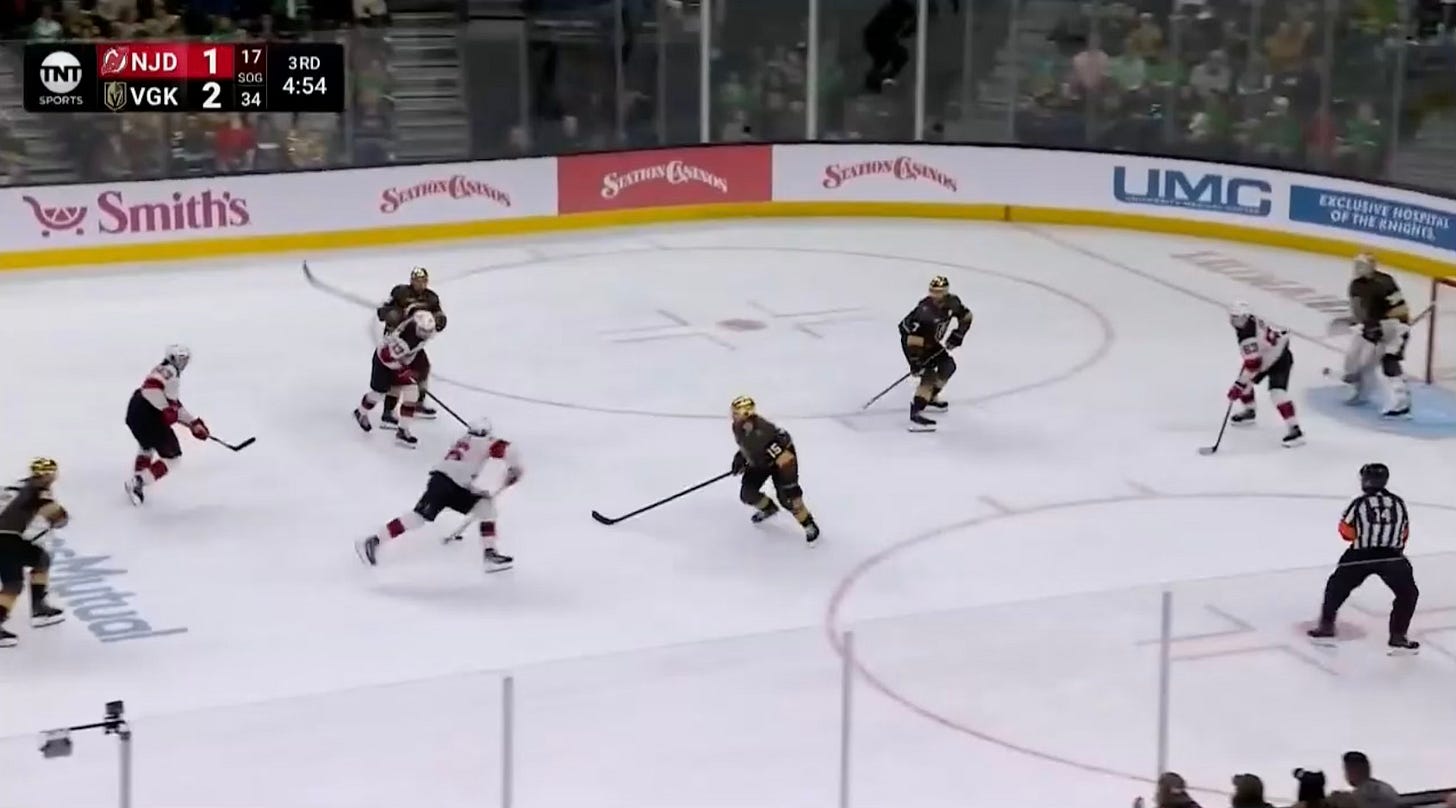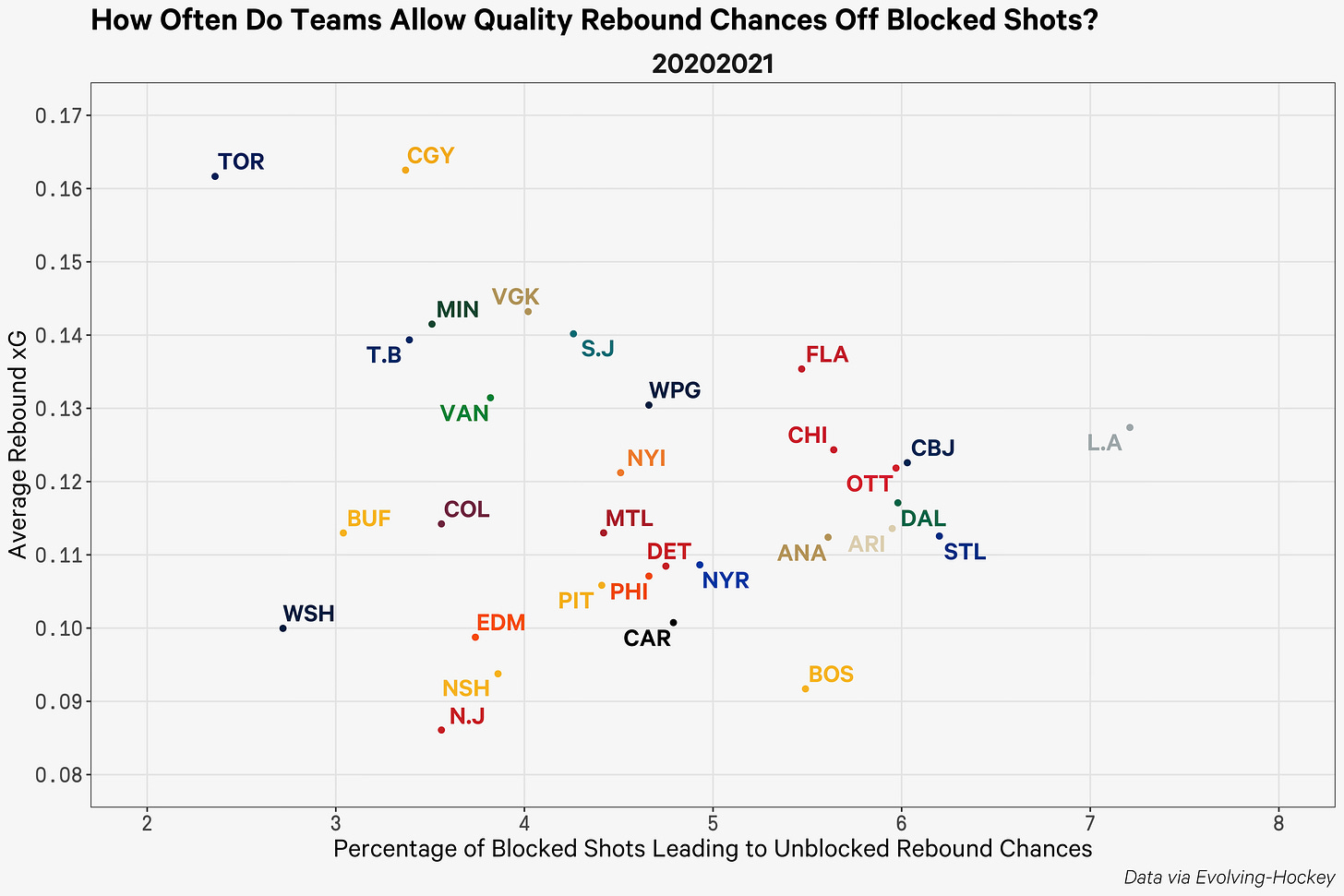To front or box out? Looking at how NHL teams systematically block shots
I got stuck in a tactical wormhole this week and you have to come with me.

NHL teams block shots at a higher rate than ever before.
Or at least since it was officially tracked starting with the 2005-06 season.
The NHL record for shot blocks per 60 minutes was set by the Calgary Flames during the 2014-15 season, with 18.72 per/60.
This season six NHL teams — the Vegas Golden Knights, Philadelphia Flyers, San Jose Sharks, New York Islanders, Flames, and Montreal Canadiens — are on pace to have top-10 all-time shot blocking seasons.
Vegas, which averages 18.57, Philadelphia (18.53), and San Jose (18.45) have a theoretical chance of breaking the Flames’ old record by the end of the season.
Heading into games on March 21, 14 NHL teams were averaging more than 16 blocks per game. Only four teams were averaging less than 14 per game.
Here is the NHL’s entire list, sorted by blocks per 60.
There are a couple reasons we’ve reached this point.
For starters, players are better protected. One of the detriments to blocking shots in the past, emotionally speaking, was the likelihood of a player breaking a foot while doing so.
Skate technology has advanced and the likelihood of a player breaking a foot while shot blocking has greatly decreased.
It also helped with the slow death of the slap shot. The big windup, while scary, is easier to read than the wrist and snapshots that have taken it’s place.
Coaches have also systematically made shot blocking more common, and Vegas winning the Stanley Cup in 2023 — while blocking 17.94 shots per 60 — has led to defensive copy cats across the league.
The Golden Knights defensive system relies on both defensemen holding their posts, and geographically keeping the other team to the outside. Vegas is willing to trade possession for positioning in the defensive zone.
When the other team grows tired of failing to get to the slot, Vegas players go to front the shot for a block, with a high-level of success.
Here’s a good screen grab from a recent game against the Devils.
The Golden Knights have effectively conceded the front of the net, not gone for the tie up, and fronted the shot for a play that was blocked and cleared the zone.
Here is another screengrab, this one against Calgary. Again the opponent is essentially given the front of the net, and the defenders are fronting the shot.
It works well for Vegas. Actually it works extremely well because they do so with a larger, strong-skating core of defenseman, who often win the area battle on size alone.
Because of their roster construction, and size, Vegas will often look like they are both boxing out in front of the net and going for the block at the same time.
That’s Vegas, most teams don’t have six defenders all 6-foot-2 or taller and weighing more than 200 pounds.
For most other teams, it’s a balance of finding the right fit and creating a system where the defensemen are trusted to make the right read on whether they are boxing out or fronting the shot.
I reached out and spoke to a handful of NHL and AHL coaches about this concept. All of them under anonymity, so they could speak freely.
There are a couple key factors coaches pointed out to me, including what type of in-zone coverage a team is running.
If a team is running man-to-man in the defensive zone, there are naturally more boxout opportunities and a boxout can start away from the net, in the corners for example, where it doesn’t hurt overall coverage.
If a team runs a zone defense, where players are responsible for space as opposed to a player, a team will front shots more.
One NHL coach, told me in his view it’s teams that don’t force a defender to choose one way or the other that have the most success.
“Vegas for example, they front all the time, it’s very simple and they don’t give space for the defenders to make a poor read,” the coach said. “Carolina is the opposite, but they are so strict man-on-man, where the players know it’s a box out all the time.”
It’s fitting that the coach mentioned those teams. Vegas leads the leagues in blocks per 60, Carolina is 32nd with a league-low 11.22 blocks per 60.
One NHL coach, whose team runs a man-to-man defense, said he wants his players to box out first. They can read the block if there is a wrist shot coming from the blue line, but otherwise blocks aren’t the top priority.
Here’s an example from Carolina, where a shot block comes only after the boxout and owning space in front of the net has been the priority.
Another coach said he believes in having his players boxout as plays exit the corner and pucks go low to high. Preventing the opponent from getting to the net and creating what he calls a “goalie bubble,” around the crease.
But if that bubble hasn’t been established, and the opponent has gotten to the front of the net, he said he wants his defender to read fronting the shot and being ready for potential stick lifts on rebounds.
“No need to get into a battle once position has been established, then it’s just creating a double screen,” they said.
Here’s a good video I found on the subject from 2018 Canadian Olympic coach Laura Schuler, which I think helps illustrate how and when players should read these situations.
I also asked players about this, about where and when they’d make the read.
Red Wings defenseman Moritz Seider said it’s a combination of tracking the man and the puck.
“If my guy is going up the wall and then plays the puck, I’m probably going to box out on his way to the net, focus on getting inside positions,” Seider said. “But when skates below the goal line, and gets a path to the net, I’m probably going to front. At that point I don’t need to be fighting, potentially screening my goalie or getting a penalty that you can get from the long box out.”
Golden Knights defenseman Ben Hutton said he often makes a boxout read based off the player around the crease.
“I think you have to be honest with yourself about the ability to win the battle,” Hutton said. “Like if it’s a big guy, and that battle is going to make it harder for our goalie, just based on the effort required, fronting the shot is the best play there.”
What about after the block?
Golden Knights coach Bruce Cassidy said that one of the internal debates he and his staff have is about whether the team is doing enough after they’ve blocked the shot.
We often talk about rebounds off the goalie, but what about rebounds off a blocked shot? If a blocked shot goes right back to the other team for a scoring chance, is it really a great play?
Thankfully, my good pal and Expected by Whom? co-host Prashanth Iyer, helped me pull the data on this to help answer Cassidy’s question.
Using NHL official play-by-play data, Prashanth pulled rebound shots off blocks.
Using a similar formula to what War-On-Ice uses for rebound shots against a goalie, he pulled any shot attempted against within three seconds of a block.
For example, the Detroit Red Wings have blocked 995 shots this season at even strength, 93 of them have been followed up directly by a rebound shot.
Prashanth then pulled the expected goal value of these rebound chances, to better quantify which teams are giving up quality chances after a block.
The below chart is for this season of 5-on-5 blocks, and for context the Winnipeg Jets are the NHL’s best team at being effective blockers, with less than six percent of blocks result in a rebound and the average value of those chances being the second best in the league.
The Washington Capitals are the league’s worst in this space. They give up more rebound chances per block and typically give up higher-danger chances after each block.
In simple terms, the closer to the bottom left of the graph, the better.
You’ll notice Vegas tests well in this space, so Cassidy’s internal debates can probably end with them sticking with their current formula.
I think it’s also important to look at this data with proper context of how many shots a team blocks. Because of how few shots they block, this chart shouldn’t be of any worry to the Hurricanes — it’s not really part of their game.
It should be a slight concern for Washington, which fronts shots often. Maybe Spencer Carbery and his staff should be examining how and when the Capitals are blocking shots back to their opponents.
At the end of the day, Cassidy’s internal debate isn’t a major problem. Although, it is always good for a coach to be thinking about ways his team could improve in this facet of the game.
Because it’s good to add further context. Here is the data for each of the past three seasons, Prashanth and I also have the full raw data available and if you’d like to do something with it please reach out and we are happy to share it for other projects.
Overall, shot blocking, in my view is no longer a measure of effort or hockey toughness.
It used to be, it used to hurt more to block shots and it was more effort based. We’ve seen classic videos of players laying out to block shots. That still happens, it’ll still get stick taps from the bench. But most shot blocks now, and there are more than ever, are simply part of the defensive scheme and players are better guarded that we sometimes miss the block is even happening.









Thank you for correcting the Caps’ coaches name (or was I seeing things?) 😁
Love this! Makes me a smarter fan and helps enhance enjoyment watching. And a great Sportstoons cartoon! Win-win-win all around!